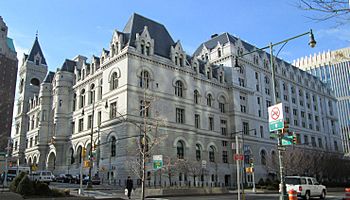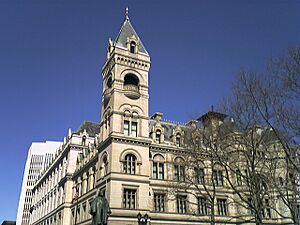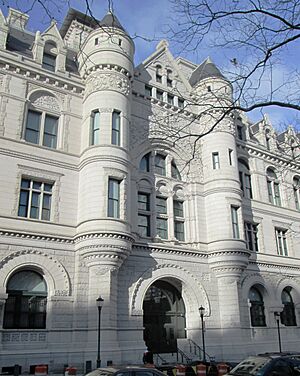Federal Building and Post Office (Brooklyn) facts for kids
|
Federal Building and Post Office
|
|

The original building (left) and north addition (right)
(2013) |
|
| Location | 271-301 Cadman Plaza East Brooklyn, New York City |
|---|---|
| Area | 1.5 acres (0.61 ha) |
| Built | 1885-91 1930-33 (north addition) |
| Architect | Mifflin E. Bell, William A. Freret Office of the Supervising Architect under James A. Wetmore (north addition) |
| Architectural style | Romanesque |
| NRHP reference No. | 74001250 |
Quick facts for kids Significant dates |
|
| Added to NRHP | October 9, 1974 |
The Federal Building and Post Office is a historic building in Brooklyn, New York City. It has served as a post office, a courthouse, and an office building for the United States government. The original part of the building was once the main post office for Brooklyn. Today, the northern part of the building is a courthouse for bankruptcy cases. This court handles financial problems for people and businesses. In 2009, the building was renamed the Conrad B. Duberstein United States Bankruptcy Courthouse. This was done to honor Conrad B. Duberstein, who was a chief bankruptcy judge.
Contents
Building History
Early Design and Construction
Planning for a new post office in Brooklyn started in 1885. Mifflin E. Bell, a supervising architect for the U.S. Treasury Department, designed the building. He chose the Romanesque Revival style. This style was popular at the time. The building was meant to be both a post office and a courthouse. It had four courtrooms.
Most of the money for the building was used to buy the land. The land is located between Cadman Plaza East, Johnson, Adams, and Tillary streets. After Bell left his job, another architect, William A. Freret, changed the design. Freret's design was bolder than Bell's original idea. Some fancy details, like larger corner towers, were not built in the final design.
Construction of the building finished in 1891. The inside areas were completed in 1892, and people started using the building. Soon after, three elevators for people and one for mail were installed.
Adding More Space
As Brooklyn's population grew, more space was needed. The original building only used the southern half of the land. So, an addition was built to the north. In 1930, the Office of the Supervising Architect designed this new part. It matched the style of the original building. This addition was finished in 1933. Two new courtrooms were added as part of this expansion.
Landmark Status and Renovations
The U.S. General Post Office became a landmark in 1966. This was decided by the New York City Landmarks Preservation Commission. It was also added to the National Register of Historic Places in 1974. In 1999, the General Services Administration (GSA) bought the building. They started big renovations. These included adding new courtrooms and fixing old ones. They also restored original windows and other parts of the building, both inside and out. Today, the building still offers postal services. It also houses the U.S. Bankruptcy Court and other government offices.
Building Architecture
Romanesque Revival Style
The Federal Building and Post Office is a great example of Romanesque Revival architecture. It is an important part of the city's Municipal Center complex. The original part of the building is four stories tall. The addition from 1933 is seven stories tall. The outside of the building has stayed mostly the same over the years.
The building's design has many features of the Romanesque Revival style. The main part of the building has strong, simple shapes. Large, powerful arches are a key feature on the first floor. Fancy dormer windows, iron roof cresting, and a steep roof give the building a unique look. A tall tower also adds to its picturesque quality.
Exterior Details
The outside of the building uses many different materials and textures. Semi-circular parts called tourelles stick out from the building. Each floor looks a little different. They are separated by stone bands that go around the building.
The first floor has round arches made of polished granite. These arches have carved rosettes and cable patterns. They rest on carved posts with leaf designs. The second floor has rectangular windows with contrasting trim. The third floor has round-arch openings. The fourth floor has steeply sloped dormer windows with round arches. A slate-covered mansard roof sits on top. It has decorative ironwork along its edge.
The square corner tower rises above the roof of the original building. It has arched openings with semi-circular balconies. An ornate cornice sits above these, topped by a steeply sloped pyramid-shaped roof.
Interior Spaces
One of the most important inside areas is the atrium. It is in the center of the original 1892 building. It goes from the second to the fourth floor. The atrium is surrounded by a three-level loggia. Each level of the loggia is held up by cast-iron columns. These columns are decorated with leaf designs.
The main staircase is in the northeast corner of the original building. It has a decorative cast-iron balustrade with lantern-style newel posts. The stairs are made of soapstone. The walls of the stairwell are covered with mahogany Tennessee marble. The floors have black and white marble tiles laid diagonally.
The walls of the 1892 courtrooms are also covered with mahogany Tennessee marble. They have black soap-stone bands. Large round-arch windows have carved wood frames. They are opened with metal pulls shaped like griffin heads. One courtroom has a fireplace made of marble and soapstone. It has a carved leaf pattern and a marble mantel. Other fireplaces are found in some of the original office spaces.
Modern Updates
Some parts of the building's interior have changed over time. During World War II, a skylight and a special ceiling light were covered. This was to follow blackout rules to protect against enemy bombings. In 1980, the large lobby of the original building was changed. Most of its original features were removed.
In 1999, the GSA started a big renovation project. This was to make space for the U.S. Bankruptcy Court and U.S. Attorneys. In 2003, a U-shaped green-glass and aluminum wall was added to the 1933 part of the building. This created an inside atrium. New skylights also let in natural light. The GSA also fixed stone, metal, plaster, and wood finishes inside. They restored old windows and doors. Three new courtrooms were added. Outside, the cast-iron roof cresting was repaired. New streetlights were also installed. This design won an award from the GSA in 1998.
Between 2010 and 2013, the GSA worked on a major exterior restoration. This was to protect the award-winning interior. The work included fixing or replacing a lot of the granite and terracotta on the outside walls. They also replaced a large area of the slate roof and many wood windows. This project won several awards, including the Lucy G. Moses Preservation Award in 2014.
See also
 In Spanish: Federal Building and Post Office (Brooklyn) para niños
In Spanish: Federal Building and Post Office (Brooklyn) para niños






